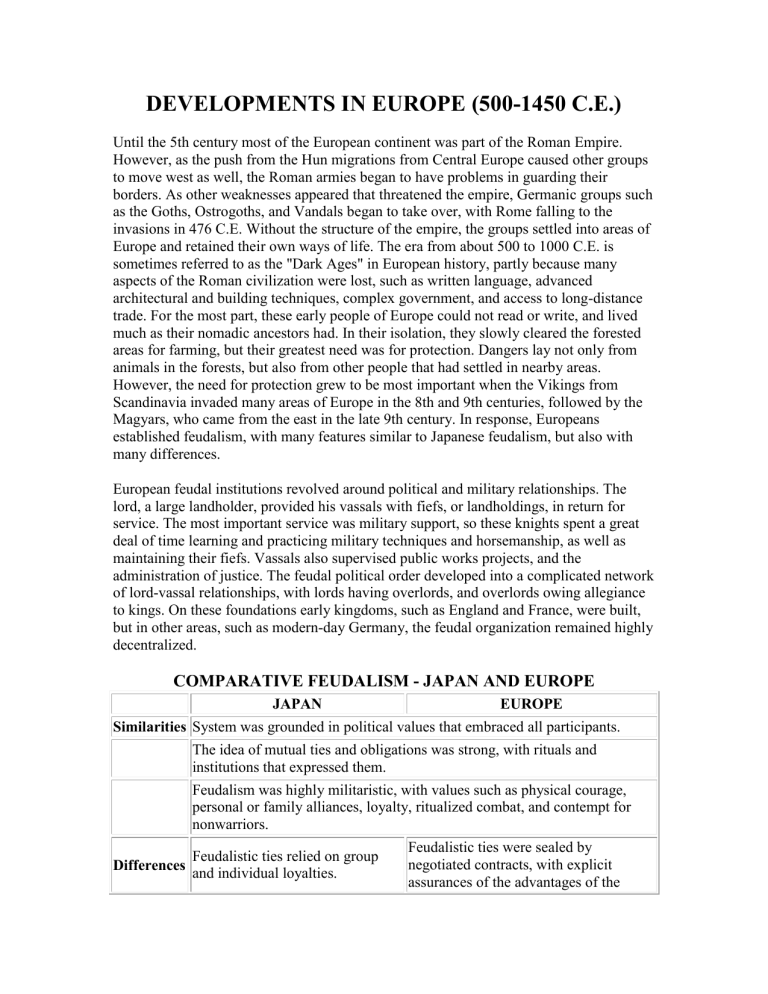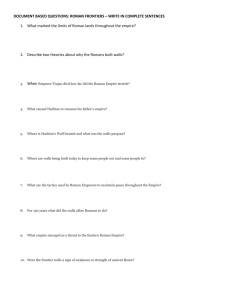DEVELOPMENTS IN EUROPE (500

DEVELOPMENTS IN EUROPE (500-1450 C.E.)
Until the 5th century most of the European continent was part of the Roman Empire.
However, as the push from the Hun migrations from Central Europe caused other groups to move west as well, the Roman armies began to have problems in guarding their borders. As other weaknesses appeared that threatened the empire, Germanic groups such as the Goths, Ostrogoths, and Vandals began to take over, with Rome falling to the invasions in 476 C.E. Without the structure of the empire, the groups settled into areas of
Europe and retained their own ways of life. The era from about 500 to 1000 C.E. is sometimes referred to as the "Dark Ages" in European history, partly because many aspects of the Roman civilization were lost, such as written language, advanced architectural and building techniques, complex government, and access to long-distance trade. For the most part, these early people of Europe could not read or write, and lived much as their nomadic ancestors had. In their isolation, they slowly cleared the forested areas for farming, but their greatest need was for protection. Dangers lay not only from animals in the forests, but also from other people that had settled in nearby areas.
However, the need for protection grew to be most important when the Vikings from
Scandinavia invaded many areas of Europe in the 8th and 9th centuries, followed by the
Magyars, who came from the east in the late 9th century. In response, Europeans established feudalism, with many features similar to Japanese feudalism, but also with many differences.
European feudal institutions revolved around political and military relationships. The lord, a large landholder, provided his vassals with fiefs, or landholdings, in return for service. The most important service was military support, so these knights spent a great deal of time learning and practicing military techniques and horsemanship, as well as maintaining their fiefs. Vassals also supervised public works projects, and the administration of justice. The feudal political order developed into a complicated network of lord-vassal relationships, with lords having overlords, and overlords owing allegiance to kings. On these foundations early kingdoms, such as England and France, were built, but in other areas, such as modern-day Germany, the feudal organization remained highly decentralized.
COMPARATIVE FEUDALISM - JAPAN AND EUROPE
JAPAN EUROPE
Similarities System was grounded in political values that embraced all participants.
Differences
The idea of mutual ties and obligations was strong, with rituals and institutions that expressed them.
Feudalism was highly militaristic, with values such as physical courage, personal or family alliances, loyalty, ritualized combat, and contempt for nonwarriors.
Feudalistic ties relied on group and individual loyalties.
Feudalistic ties were sealed by negotiated contracts, with explicit assurances of the advantages of the
arrangement.
Legacy was a group consciousness
Legacy was the reliance on parliamentary institutions in which in which collective decisionparticipants could discuss and defend making teams were eventually legal interests against the central linked to the state. monarch.
THE DIVISION OF CHRISTENDOM
The Roman Empire was divided into two parts during the 4th century C.E. when imperial power shifted eastward from Rome to Byzantium. The emperor Constantine moved to the new center, and renamed the city Constantinople. As Christianity spread, it developed religious centers in both Rome and Constantinople, and as the two areas grew more politically independent, Christian practices and beliefs also split in different directions.
Even though the church remained officially tied for many years after Rome fell in 476, in effect two different churches developed: the Eastern Orthodox Church in the east and the
Roman Catholic Church in the west. The schism became official in 1054, when the
Roman Pope and the Patriarch in Constantinople agreed that their religious differences could not be reconciled.
THE BYZANTINE EMPIRE
While the west was falling to the Germanic invasions in the 4th and 5th centuries C.E., the eastern empire remained intact, partly because it withstood fewer attacks. This
Byzantine Empire survived for almost a millennium after the western empire collapsed.
For a time, it was a powerful Christian Empire, but it came under pressure from Islamic
Turkish people by the 11th century, and finally fell to the Ottoman Turks in 1453.
Caesaropapism
As the first Christian Emperor of Rome, Constantine claimed to have divine favor for his rule. He defined Christian practices and intervened in theological disputes. This policy came to be known as "caesaropapism", whereby the emperor ruled as both secular lord and religious leader. This tendency to exalt Byzantine emperors as absolute rulers of both state and church was reinforced by the appearance of Justinian in the 6th century. He was an energetic, capable ruler with an energetic, capable wife called Theodora, a very religious Christian. Although they never resolved the many religious disputes that disrupted the empire, Justinian had many noteworthy accomplishments:
The building of the Hagia Sophia, a magnificent domed church that still stands today as a Muslim mosque
Extension of the political boundaries of the empire to regain most of the western
territories again, only to be lost by later emperors
The development of the Justinian Code, a law code that systemized Roman law going back to the Republic and continuing through the empire
Of the accomplishments listed, the Justinian Code is the emperor's most enduring legacy, since it became the basis of law in western Europe and eventually the
United States.
The Decline of the Empire
Even Justinian could not revive the classical Roman Empire, and within 100 years of his death, large parts of the Byzantine Empire fell to Arab invaders. It thrived for a while as a smaller, more manageable entity, but by the late 11th century, the Seljuk Turks threatened Constantinople so that the Patriarch of the Eastern Orthodox Church called on
Pope Urban II for help in defending the capital by Christian Crusaders.
THE CHURCH IN THE WEST
While political and economic decentralization characterized western Europe between 500 and 1000 C.E., the Catholic Church emerged as a unifying institution with great religious, political, and economic power. The time period is sometimes referred to as the "Age of
Faith" because the church was so central to life in Europe.
The power of the church was promoted by an unlikely Germanic group known as the
Franks. They controlled much of what is now France by the 5th century C.E. when their leader Clovis led his forces on a campaign that wiped out the remains of Roman authority a few years after Rome's fall in 476. Clovis converted to Christianity, under some pressure from his wife, and from then, the Franks' conquests were done in the name of
Jesus. One of his descendants, Charlemagne, ruled a kingdom that spread across a huge part of Europe, including both modern day France and Germany. Charlemagne was able to rescue the Roman Pope from captivity, and the Pope returned the favor by crowning
Charlemagne as the new "Holy Roman Emperor," uniting church and state. Still, the Pope was the one controlling the crown, and the ceremony took place in Rome.
The Catholic Church established its influence in several ways:
Development of a church hierarchy - The Pope in Rome came to be the head of the church, with cardinals that reported to him. Under the cardinals were archbishops, who governed bishops that were spread all over Europe. Individual priests lived in villages and towns and were supervised by the bishops.
Establishment of wandering ministries - Not only did the church have priests attached to almost every village, but it also had wandering priests who represented its influence. Two orders were the Franciscans, known for their vows of poverty and ability to relate to peasants, and the Dominicans, a more scholarly order who ministered more to educational needs.
The establishment of monasteries- Monasteries also spread all over Europe. These retreats from civilization were inhabited by monks who devoted their lives to study, worship, and hard work. Convents for nuns also were established, and both monasteries and convents served many vital functions:
1) Refuge for those in trouble - The monasteries and convents were seen as safe havens that represented the protection that the church offered to people.
2) Communication to the central church hierarchy - Abbots headed monasteries, and they served as another means of keeping church officials in touch with what was going on.
3) Centers of scholarship, education, and libraries - Monks very often were the only people in Europe that could read and write, and they spent large amounts of time copying ancient manuscripts that otherwise might have been lost in the various invasions. Some monasteries eventually formed the first European universities that began their library collections with books the monks had coped.
THE MANORIAL SYSTEM
Feudalism generally defined the military and political relationships among kings, nobles, and knights, but manorialism describes the economic and political ties between landlords and their peasants. Most people were serfs, who farmed self-sufficient agricultural estates called manors. The manorial system had originated in the late Roman Empire as it helped people take care of basic economic needs as the empire weakened. Farming was difficult, although made easier by the introduction of the moldboard plow that allowed deeper turning of the soil.
Serfs had to give their lord part of their crops in return for grazing their animals on his land and milling their grain. They also did repairs to his castle and worked his land. They were not slaves, but few other options were open to them. The lord's castle and army in turn provided protection for the villages, and few dared to live outside the confines of the manor.
THE LATE MIDDLE AGES - 1000- 1450 C.E.
The entire era in Europe between 500 and 1450 is also known as the "Middle Ages," a time between the fall of the Roman Empire and the revival of "civilization" starting with the European Renaissance in the early 15th century. Starting around 1000, Europe showed signs of revitalizing, largely because of the results of the Christian Crusades that put Europeans in touch with more sophisticated cultures to the east through the longdistance trade routes.
Before about 1300 Europe was populated by serfs, or peasants tied to lands owned by nobility, living in rural areas relatively isolated from others. No large cities existed yet, like the metropolises in China, the Middle East, and northern Africa. Many demographic changes took place that radically altered life in Europe:
The Agricultural Revolution - Largely through contacts with others, Europeans learned and adapted agricultural techniques and inventions that greatly increased their crop production. They perfected the three-field system, in which they rotated
crops, allowing a field to remain fallow every third year. They also used iron plows much better suited to the heavy soils of northern and western Europe.
Watermills, horses, and horse harnesses (all in use in other areas of the world) contributed to farming efficiency.
Population increases - With the increase in crop production came population growth, with more hands available to expand agriculture.
Revival of trade - This revival started in Venice and Genoa, Italian cities that profited from trade during the Crusades. However, the growing population sparked demand for more products so that trade intensified town to town, and a new trade area in present-day northern France, Belgium, and the Netherlands.
Growth of towns/new towns - The growing trade, crop production, and population stimulated villages to become towns, and the towns became centers for craftsmen, merchants, and specialized laborers.
Commercial Revolution - Once European towns connected to the long-distance trade routes, they learned to use financial innovations developed elsewhere, like banks and bills of exchange
Guilds - Craftsmen formed guilds, or trade associations for their particular craft.
These organizations came to be quite powerful, passing laws, levying taxes, and challenging powerful merchants. The guilds set standards for goods, regulated labor, and supervised apprentices as they learned the trade.









